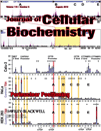
MOLECULAR AND CELLULAR BIOLOGY
Scope & Guideline
Exploring the Depths of Molecular Complexity
Introduction
Aims and Scopes
- Molecular Mechanisms of Disease:
Research focusing on the molecular pathways and genetic factors contributing to various diseases, including cancer, metabolic disorders, and infectious diseases. - Cellular Signaling and Communication:
Studies examining the mechanisms of cell signaling, including receptor-ligand interactions, intracellular signaling cascades, and the role of extracellular vesicles in cell communication. - Stem Cell Biology and Regenerative Medicine:
Investigations into stem cell differentiation, maintenance, and applications in regenerative medicine, including the use of stem cells for tissue engineering and therapy. - Genomic and Epigenomic Regulation:
Research exploring gene expression regulation through genomic and epigenomic modifications, including the role of non-coding RNAs and histone modifications. - Biotechnology and Therapeutic Innovations:
Studies that apply molecular and cellular biology techniques to develop novel therapeutic strategies, drug delivery systems, and diagnostic tools.
Trending and Emerging
- Role of Non-Coding RNAs:
There is a growing focus on the functional roles of long non-coding RNAs and microRNAs in regulating gene expression and their implications in cancer and other diseases. - Cellular Response to Environmental Stressors:
Research investigating how cells adapt to various stressors, such as hypoxia, oxidative stress, and inflammation, is increasingly relevant, particularly in the context of chronic diseases. - Advanced Imaging and Computational Techniques:
The use of cutting-edge imaging techniques and computational models to study cellular processes in real-time is on the rise, allowing for deeper insights into dynamic biological systems. - Metabolomics and Systems Biology Approaches:
Integrating metabolomics with genomics and proteomics to understand cellular metabolism and its relationship with disease states is becoming a prominent area of study. - Therapeutic Targeting of Cellular Pathways:
Research aimed at identifying and targeting specific cellular pathways for therapeutic interventions, particularly in cancer and metabolic disorders, is gaining momentum.
Declining or Waning
- Traditional Genetic Studies:
Research relying solely on classical genetics approaches is waning, as more sophisticated techniques like CRISPR and genomic sequencing gain traction. - In Vitro Models of Disease:
The focus on standard in vitro models is decreasing in favor of more complex systems such as organoids and 3D cultures that better mimic in vivo conditions. - Basic Cell Culture Techniques:
Publications centered on basic cell culture methodologies are becoming less frequent, as the community moves towards more advanced techniques and applications. - Single-Cell Analysis in Limited Contexts:
While single-cell analysis is gaining attention, studies that apply single-cell techniques without sufficient context or biological relevance are less favored.
Similar Journals

JOURNAL OF BIOLOGICAL CHEMISTRY
Shaping the Future of Biological SciencesJOURNAL OF BIOLOGICAL CHEMISTRY, published by Elsevier, is a premier interdisciplinary journal dedicated to advancing our understanding of biochemistry, cell biology, and molecular biology. With a prestigious history dating back to 1945 and an impressive convergence of research expected to continue through 2024, this journal holds a Q1 ranking in all three of its core categories, signaling its critical influence in the respective fields, supported by a robust Scopus ranking that places it among the top echelons of internationally recognized research. Although currently not available as Open Access, the journal is essential for researchers and professionals looking to stay abreast of the latest breakthroughs and innovations in biochemical research. With a deep commitment to scientific rigor and a focus on diverse topics ranging from cellular processes to molecular mechanisms, the Journal of Biological Chemistry serves as a vital resource for the academic community, shaping the future of biological sciences.

SEMINARS IN CELL & DEVELOPMENTAL BIOLOGY
Shaping the Future of Developmental ResearchSEMINARS IN CELL & DEVELOPMENTAL BIOLOGY is a premier journal published by Academic Press Ltd - Elsevier Science Ltd, focusing on the vital domains of cell and developmental biology. With an impact factor that reflects its rigorous contributions to the field, this journal embodies the highest standards of academic excellence, currently ranking in the Q1 quartile for both Cell Biology and Developmental Biology categories as of 2023. Researchers and practitioners will appreciate its robust Scopus ranking, placing it within the top tiers of developmental biology and cell biology, with percentile ranks of 94th and 90th respectively, showcasing the journal's influential presence in the scientific community. The journal aims to disseminate comprehensive reviews, cutting-edge research articles, and significant advances in the understanding of cellular mechanisms and developmental processes, thereby catering to a diverse audience that includes researchers, scholars, and students dedicated to the life sciences. Given its commitment to open access, SEMINARS IN CELL & DEVELOPMENTAL BIOLOGY promotes widespread dissemination of knowledge, enhancing collaborative research efforts and driving innovation across biological disciplines.

Cell and Bioscience
Unlocking the Secrets of Life at the Cellular LevelCell and Bioscience is a prestigious open-access journal published by BMC that has been at the forefront of biochemistry, genetics, and molecular biology since its inception in 2011. With an impressive impact factor, this journal has established itself as a vital resource for researchers and professionals in these rapidly advancing fields, reflecting its high ranking of #29 out of 221 in the Scopus classification and placing it in the 87th percentile. Based in the United Kingdom, Cell and Bioscience aims to foster innovation and dissemination of research findings addressing critical biological questions through rigorous peer-reviewed articles and inter-disciplinary approaches. The journal's open-access model ensures unrestricted access to transformative research, promoting collaboration and knowledge sharing among academics, students, and practitioners worldwide. With a commitment to maintaining excellence in the field, Cell and Bioscience provides an essential platform for those looking to contribute to the evolving landscape of biosciences.

Journal of Molecular Cell Biology
Fostering collaboration in cutting-edge cell biology.The Journal of Molecular Cell Biology, published by Oxford University Press, is a leading platform for groundbreaking research in the fields of cell biology, genetics, and molecular biology. With an impact factor that places it in the Q1 and Q2 quartiles across key academic categories, this journal has become an essential resource for researchers and professionals committed to advancing our understanding of cellular mechanisms and genetic processes. Since becoming Open Access in 2019, it has enhanced the accessibility of high-quality research, fostering collaboration and knowledge sharing within the scientific community. The journal's Scopus rankings reflect its significant impact in the field, particularly in genetics and molecular biology, ranking within the top percentiles. With a convergence of research spanning from 2009 to 2024, the Journal of Molecular Cell Biology remains at the forefront of innovative discoveries and critical discussions, making it a vital resource for students, academics, and industry experts alike.

Biology Direct is a leading open-access journal published by BMC, dedicated to disseminating groundbreaking research in the fields of biological sciences. Since its inception in 2006, the journal has emerged as a pivotal platform for scholars, researchers, and practitioners, providing unrestricted access to high-quality, peer-reviewed articles that cover a wide spectrum of topics, including biochemistry, ecology, and applied mathematics. With an impressive ranking in the first quartile across multiple scientific categories, including Agricultural and Biological Sciences and Biochemistry, Genetics, and Molecular Biology, Biology Direct is recognized for its rigorous standards and impactful contributions within the academic community. The journal's open-access model ensures that research findings reach a global audience, fostering collaboration and innovation. Researchers and students looking to stay ahead in the rapidly evolving biological sciences will find Biology Direct an invaluable resource for knowledge and insight.

CYTOTECHNOLOGY
Exploring Cytotechnological Frontiers: Where Research Meets Application.CYTOTECHNOLOGY, an esteemed journal published by Springer, stands as a vital resource in the fields of Bioengineering, Biomedical Engineering, and Biotechnology. With an impact factor reflective of its solid position within academia, this journal encompasses a broad scope dedicated to the advancement of cytotechnological research and applications from its inception in 1987 through to its latest volumes in 2024. Based in the Netherlands, it is committed to providing researchers, professionals, and students with high-quality, peer-reviewed articles that contribute to the understanding and innovations in cytotechnology. Although currently not open access, CYTOTECHNOLOGY has garnered a commendable reputation, holding Q3 rankings in multiple categories, indicating its relevance and influence within the scientific community. Researchers are encouraged to submit their cutting-edge findings to share insights that can spark further advancements in this dynamic field.

JOURNAL OF CELLULAR BIOCHEMISTRY
Elevating Biochemical Insights for Tomorrow's ScienceJournal of Cellular Biochemistry is a premier academic journal dedicated to advancing the field of biochemistry and cellular biology. Published by Wiley, this influential journal has a significant impact factor that underscores its relevance and authority within the scientific community. With its ISSN 0730-2312 and E-ISSN 1097-4644, the journal has been on the frontier of research since its inception in 1982, and is expected to continue publishing cutting-edge studies through 2024. As evidenced by its ranking in the 2023 Scopus Quartiles, it holds a rank of Q2 in Biochemistry and Q3 in both Cell and Molecular Biology, placing it among the top tiers of scientific journals in these disciplines. The Journal of Cellular Biochemistry serves as a vital resource for researchers, professionals, and students alike, providing a platform for the dissemination of innovative ideas and findings that shape our understanding of cellular processes and biochemical pathways. Though it does not currently offer Open Access options, its robust peer-review process ensures that each publication meets the highest academic standards, thus solidifying its esteemed position in the landscape of biochemical research.

CELLULAR AND MOLECULAR BIOLOGY
Advancing the Frontiers of Life SciencesCellular and Molecular Biology is a prominent academic journal published by C M B ASSOC, specializing in the dynamic fields of cellular and molecular biology. Established in 1977, this journal has consistently aimed to disseminate groundbreaking research that contributes to our understanding of biochemical processes, cell dynamics, and molecular mechanisms governing life. With its ISSN 0145-5680 and E-ISSN 1165-158X, the journal plays a vital role in the exchange of innovative ideas, evidenced by its coverage of research from 1977 to 2024. Although currently categorized in the Q4 quartile for major disciplines such as Biochemistry and Cell Biology, it is dedicated to fostering the development of the field by welcoming submissions that challenge the conventional understanding and lead to novel insights. Researchers and academics looking to contribute to or stay updated in the rapidly evolving landscape of molecular biology will find this journal a valuable resource for connecting with a global community of scientists.

Biochemistry and Cell Biology
Connecting researchers through groundbreaking discoveries in life sciences.Biochemistry and Cell Biology, published by Canadian Science Publishing, is a prestigious journal that has been instrumental in advancing the fields of biochemistry, molecular biology, and cell biology since its inception in 1986. With an impressive scope spanning innovative research findings to comprehensive reviews, this journal serves as a vital resource for researchers, professionals, and students alike. Currently positioned in the Q2 quartile in Biochemistry and Q3 quartiles in both Cell Biology and Molecular Biology, it reflects a robust contribution to scientific discourse, placing it among reputable publications in its field. The journal boasts notable rankings within the Scopus database, highlighting its impact and relevance, and continues to be a valuable platform for disseminating pivotal research. By providing access to a wide array of articles, the journal remains committed to fostering knowledge and collaboration in the scientific community.

CELLULAR AND MOLECULAR LIFE SCIENCES
Fostering Breakthroughs in Cellular and Molecular ResearchCELLULAR AND MOLECULAR LIFE SCIENCES, published by SPRINGER BASEL AG, stands as a premier journal dedicated to advancing the field of cellular and molecular biology. With an impressive 2023 impact factor reflected in its Q1 rankings across key categories—including Cell Biology, Molecular Biology, and Pharmacology—it serves as a critical platform for researchers aiming to disseminate high-quality findings in these dynamic fields. Operated under an open access framework, the journal allows broader accessibility to groundbreaking research, fostering collaboration amongst scientists globally. Based in Switzerland, CELLULAR AND MOLECULAR LIFE SCIENCES has been at the forefront of scientific publishing since 1952, adapting to contemporary scientific challenges and trends, ultimately shaping the future of life sciences.